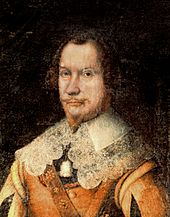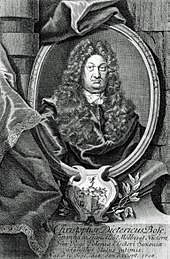Bose (noble family)
The von Bose family is a Saxon nobility that comes from the Merseburg Abbey and was resident in Saxony, Prussia, Alsace, Hamburg, the Netherlands, Russia and North America.
history
There are several legends about the origin of the family. One of them is that their original ancestral seat was the Bösenburg near Rottelsdorf in the later county of Mansfeld , where the legendary King of the Thuringians Bisino is said to have owned a castle on the castle hill. According to another legend, the family is said to have been named after the first bishop of Merseburg, Boso (r. 968–970), who came from Bavaria. Since the clergyman did not have any biological descendants, legend has it that the origin of the family is traced back to a close relative of this first bishop of Merseburg.
Like many noble families who did not name themselves after a family castle but after a property (or their coat of arms symbol), the Bose wrote themselves without the aristocratic predicate of until the 17th century . It was not until some representatives were raised to the rank of count in 1715 that the name Bose gradually began to gain acceptance.
The first documentary mentions of representatives of the family took place in 1283 and 1286 in documents of the Marienstern monastery with Dietmar, Nikolaus and Arnold Bose. The line can be traced back to 1307 on Heidenricus, miles . Johann II. Bose was bishop of Merseburg from 1431 to 1463. The family later provided a number of Saxon and Prussian generals.
The oldest family estates were in Frankleben im Saalekreis ( Unterhof and Oberhof, owned by the family from 1327 to 1945), Köttichau , Kötzschau , Kötzschen , Ammendorf , Beuna , Witzschersdorf and Naundorf .
In the course of the 16th century, a Vogtland and a Frankish-Meiningian line split off. The first line of the family was divided into the 1st branch with the Benkendorf and Delitz am Berge branch (both goods sold in 1746) and the second branch Ermlitz (all located in the Saalekreis ). The representatives of the 2nd branch were divided into the branches Schweinsburg (near Zwickau) with the Bosenhof, Mylau / Vogtland, Breitingen (near Leipzig) and Netzschkau / Vogtland with Netzschkau Castle . Carol Gottlob Bose , electoral Saxon real secret council and authorized envoy to the Reichstag in Regensburg as well as main representative of the Netzschkau branch and his descendants were on May 23, 1715 by Emperor Karl VI. raised to the rank of imperial count.
The second line of the family was also divided into two branches. One branch split into the branches Ellingshausen (1573 to 1820 and 1902 to 1985) and Helba , both located near Meiningen in Thuringia, which is dominated by Franconia, and the two branches Upper and Lower Franconia .
From the 17th century, the possession of the Mohrenhaus in Niederlößnitz west of Dresden was in the hands of the Bose family for several generations, as was the Mölbis manor from the end of the 17th century to 1789.
The Bose Family Association was founded on October 8, 1898.
Unterfrankleben Castle
Benkendorf Castle
Ermlitz Castle
Good Breitingen
coat of arms
- The family coat of arms is split from silver and black. On the helmet with black and silver helmet covers a fan-like rounded umbrella board split by silver and black .
- Since 1553 the silver-black painted shield with a red border. On the helmet with black and silver blankets, an overturned, red top hat, split by silver and black, with the tip bent to the left, the opening of which is studded with six red-tipped (three silver and three black) cock feathers.
Coat of arms in Siebmacher's coat of arms book from 1605
Important representatives



- Adam Heinrich Bose (1667–1749), General Elector of Saxony
- Carl Graf von Bose (1753–1809), ambassador to the Elector of Saxony, court marshal and cabinet minister for foreign relations, Leipzig Freemason
- Carl Adam Heinrich von Bose († 1819), German writer, forestry and agricultural scientist
- Carl August Graf von Bose (1814–1887), Privy Councilor, natural scientist and last representative of the Vogtland line raised to the nobility
- Carl Fedor von Bose (1856–1919), Councilor
- Carl Friedrich von Bose (1865–1945), composer, professor at the Leipzig Conservatory
- Carl Melchior Bose (1681–1741), councilor and consistorial councilor as well as canon and senior of the Merseburg monastery
- Carol Bose (1596–1657), Elector of Saxony and military leader at the side of Gustav II Adolf of Sweden, member of the Fruit Bringing Society ( The Preserving )
- Christiane Louise von Rochow , née von Bose (1734–1808), manor owner, social reformer
- Christoph Dietrich Bose the Elder (1628–1708), Polish and Saxon Privy Councilor, Council of War and General War Commissioner
- Christoph Dietrich Bose the Younger (1664–1741), Reichspfennigmeister as well as Polish and Saxon Real Privy Councilor
- Curt von Bose (1808–1884), German lawyer, pomologist and numismatist
- Georg von Bose (1842–1923), Prussian major general
- Hans-Jürgen von Bose (* 1953), German composer
- Harald von Bose (* 1955), German lawyer and state data protection officer for Saxony-Anhalt
- Herbert von Bose (1893–1934), German senior government councilor
- Jobst Hilmar Graf von Bose (1897–1949), German Colonel (Wehrmacht), bearer of the Knight's Cross of the Iron Cross
- Johann II. Bose († 1463), German clergyman, Bishop of Merseburg
- Johann Adolf von Bose (1850–1917), German major general
- Johann Balthasar Bose (1658–1712), German nobleman and court official, Provost of Meißen
- Julius von Bose (1809-1894), Prussian general
- Karl von Bose (1596–1657), electoral colonel and governor of Zwickau, Werdau and Stollberg, see Carol Bose
- Karl August Joseph Friedrich von Bose (1763–1826), Saxon major general, most recently Prussian lieutenant general
- Karl Friedrich Wichmann von Bose (1769–1839), Prussian major general
- Louise von Bose (1813–1883), Prussian patron and benefactress
- Thilo von Bose (1880–1934), Prussian officer and author
- Charles von Bose (1855–1927), partner and long-time representative of the Hamburg trading company Carlowitz in China
- Gabriele Stock-Schmilinsky, b. von Bose (1903–1984), daughter of Charles, painter and art teacher
literature
- Valentin König : Genealogical aristocratic history or gender description of those in the Chur-Saxon and gracing lands partly formerly, but mostly still in a good flor, oldest and most handsome noble families and from the same sprung various baronial and high-counting houses: Wherein the same Antiquity, lineages, coats of arms, division of their family houses, lordships, feudal and knight-guilders, as well as the life and deeds of the most famous high-nobility persons, Volume 3, Deer, 1736, pp. 139 ff digitized
- Bose, one of the oldest and most handsome noble families. In: Johann Heinrich Zedler : Large complete universal lexicon of all sciences and arts . Volume 4, Leipzig 1733, column 798-801.
- Ernst Heinrich Kneschke : New general German nobility lexicon , Vol. 1, Leipzig 1859
- Gothaisches Genealogisches Taschenbuch der Adeligen Häuser, Uradel , Gotha 1902, pp. 144–158
- Gothaisches genealogical pocket book of noble houses , Gotha, 1903, p.172f
- Carl Emil von Bose: genealogical tables of the von Bose family , Dresden 1902, digitized
- Carl Emil von Bose: The family of Bose: Contributions to a family history, together with family tables , Dresden 1904
- Carl Emil von Bose: Overview of the marital connections of the evil sex , 1907
- Gerhard von Bose: On the history of the Bose family , 1956
- Otto Küstermann : On the history of the Bose family , documentary news, special print from the "Quarterly journal for coat of arms, seal and family history". Issue 27, Berlin 1899










